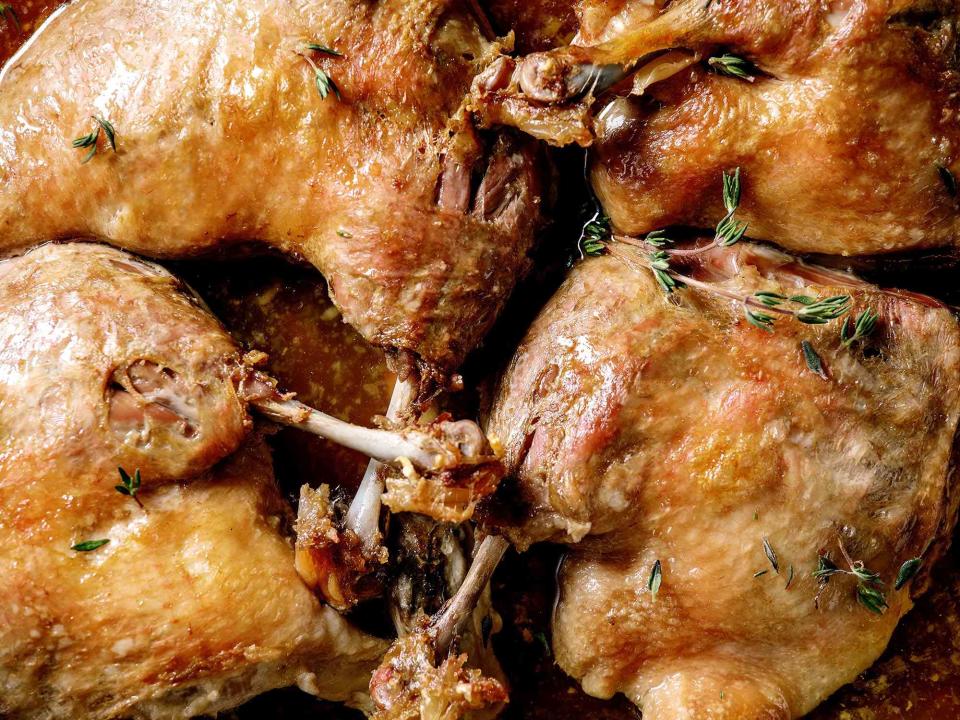What Does It Mean to Confit?
You’ve seen the word “confit” — maybe next to the word “duck” — on menus and in recipes. But what does it mean?

Natasha Breen/Getty Images
Confiting, as many wonderful culinary accomplishments do, hails from France — specifically, Gascony. As The Food Lover’s Companion explains it, it is “derived from an ancient method of preserving meat (usually goose, duck, or pork) whereby it is salted and slowly cooked in its own fat. The cooked meat is then packed into a crock or pot and covered with its cooking fat, which acts as a seal and preservative.”
So there you go: To “confit” is to cook a fatty cut of meat slowly in its own, or some other animal’s, fat — and it is unbelievably tasty. Lachlan Mackinnon-Patterson, chef of Boulder, Colorado restaurant Frasca Food & Wine, once cooked at a two-star Michelin restaurant in France, and at California’s renowned The French Laundry. He has confited many an animal. “It’s one of the classic cooking techniques of French cuisine,” he tells us, “traditionally used for duck legs.” That said, you could also confit lamb shoulder, pork shoulder, or chicken in fat; “anything that needs to be braised or tender,” says Mackinnon-Patterson. “It’s basically a way of preserving and tenderizing tough cuts of meat.”
Related:Everything You Need to Know About Braising Meat
And though the word might conjure a fancy French restaurant, tall white chefs’ hats, and difficult technique, it can actually be quite easy to achieve at home, as in this recipe. The idea is to season your meat extensively beforehand, says Mackinnon-Patterson. “Imagine you were seasoning a hamburger with salt. Season it four times as aggressively.” Salting draws moisture out of the cut you’re using, he explains. “It creates little holes so when it’s cooked in the fat, the moisture is replaced by oil.” Wait for one to three hours depending on the meat’s thickness, and then rinse off the salt before cooking it slowly at a low temperature. He suggests placing the meat in hot oil — but not oil that’s at a boil — around 170 degrees F. If you want to, you could add orange peel, herbs, sage, or thyme to the mix — “things that are herbaceous that work with the meat” — he suggests. Place the meat in fat in an oven preheated to somewhere between 200 and 240 degrees F. Your meat is done when it’s plush and tender, so test it along the way. When you remove the meat from the oven, be sure to let it cool in the fat.
If you’re trying confiting for the first time, remember that to truly “confit,” you must cook the meat in fat, not water — the chef suggests perhaps avoiding duck fat itself. “What happens is it often ends up tasting like duck fat. Of course, that’s delicious, but I’d encourage people to mess around with other lipids.” He uses “tons” of olive oil at his Italian restaurant, which “is just like, the best,” but you could also use pork fat, which many chefs swear by.
Related:For Comforting, One-Pot Winter Meals, Get to Know French Cassoulet
Serve confited meat warm, with bright ingredients such as shell beans, fennel, carrots, red pepper, a squeeze of lemon juice, or fresh-cut herbs. The classic preparation is to throw those duck legs into a fancy cassoulet — a baked dish of sausage and duck — but “a hot succulent duck leg is just delicious,” says Mackinnon-Patterson, served simply with in-season vegetables.

